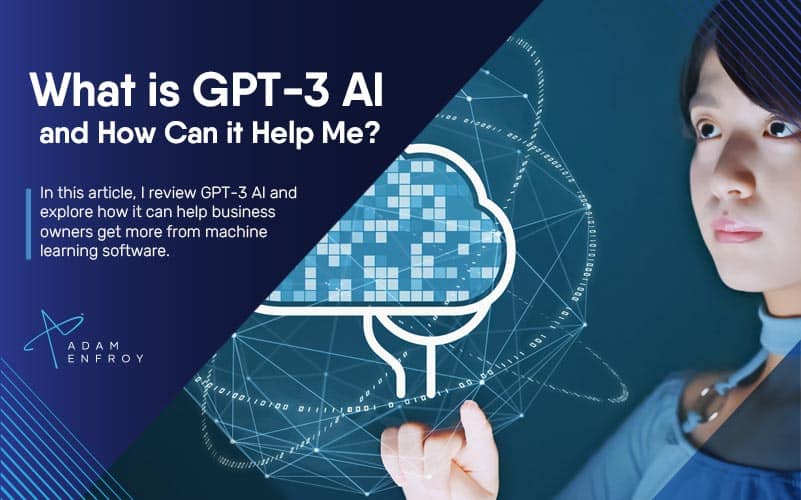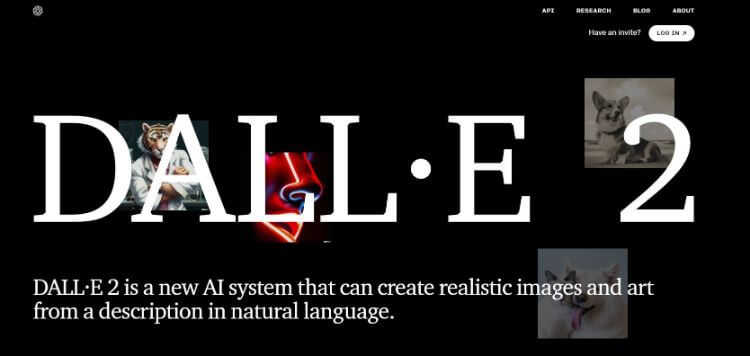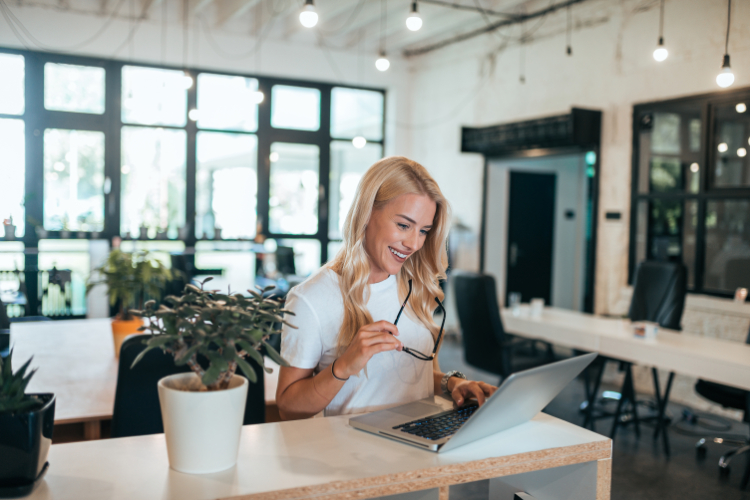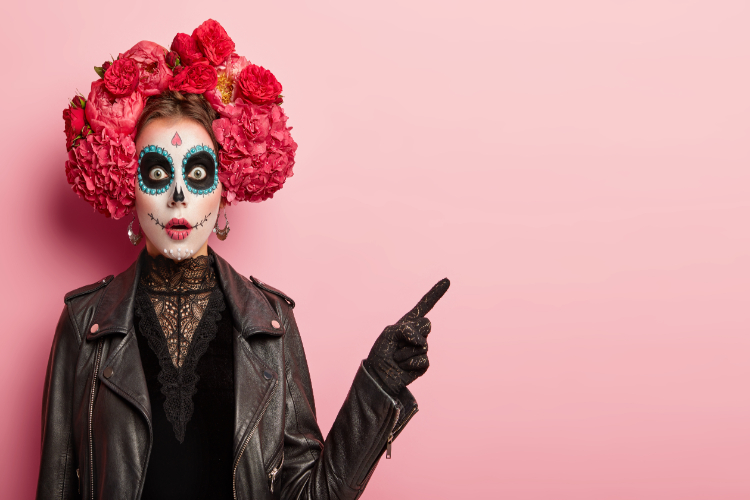What is GPT-3 AI and How Can it Help Me?

When it comes to machine learning software, we often think of platforms that can help us analyze data or make predictions.
From enterprise resource planning that ensures better inventory management to CRM software that boosts client relationships and sales, machine learning software has a range of applications in the business world.
However, as of late, an artificial intelligence called GPT-3 has been getting a lot of attention for its potential to change how we interact with various machines.
GPT-3 is a neural network created by OpenAI, an artificial intelligence research lab.

The aim of GPT-3 is to make it easier for developers to create more intelligent applications, allowing them to tap into the power of machine learning.
This has given rise to various use cases for GPT-3, ranging from automatic code generation to AI writing software that understands context and can offer suggestions accordingly.
In this article, I’ll take a closer look at GPT-3 AI and how it can help you, the business owner, to get more from machine learning software both now and in the future.
What is GPT-3 AI?
OpenAI created the Generative Pre-trained Transformer 3 (GPT-3), an AI platform that enables developers to train and deploy AI models.
It offers a wide range of benefits, including the ability to improve model accuracy and performance, as well as reduce training time and costs.
With natural language processing (NLP) features, GPT-3 can read into and understand various patterns.
With ChatGPT being one of the most advanced natural language processing programs showing the power of GPT-3, many are optimistic about the potential of this technology.
There are, in fact, multiple ways to make money with ChatGPT and the GPT-3 technology.
In addition to understanding text, GPT-3 can generate new text that is grammatically correct and relevant to the context.
This makes it an ideal platform for machine translation, question answering, and building AI chatbots.
GPT-3 is still in its early stages but has already shown great promise and growth over the last few years.
With various data science language models able to work on different tasks, GPT-3 is the go-to platform for AI development.
Being a powerful language model, GPT-3 has the potential to impact the field of natural language processing even more.
What Makes GPT-3 So Special?
GPT-3 isn’t the first system to be able to produce text, but what makes it unique is how much it has learned and how little training it now requires.
Traditionally, a language prediction model had to be told what to write about in great detail before it could generate anything remotely human-like.
In contrast, GPT-3 was given a large amount of training data (text) and left to learn by itself.
Due to the pre-training the model received, it learned the rules of grammar and syntax, the meaning of words, and how they are used in millions of varying contexts.
Another aspect that makes this machine learning model unique is its use of a masked learning model.
Here, the learners as part of the model are never given the entire text but only a tiny part.
The model then has to predict what comes next in the sequence, which means that each word it produces depends on the previous ones.
This results in more human-like text, as it captures the dependencies between words often seen in natural language.
This also eliminates the need for expensive labeled data, as the model can predict what the next word should be, based on the context.
Finally, as the model’s third version, GPT-3 has significantly improved over its predecessors.
Use Cases Of GPT-3
So what does this all mean for those that want to use this neural network model in their business?
Considering the deep learning capabilities, several potential use cases exist to maximize GPT-3’s ability.
Some of these applications include the following.
Chatbots
Using various APIs that integrate with GPT-3, you can train business chatbots to have them generate human-like responses.
This is made possible by the fact that GPT-3 can understand the context of a conversation, as well as generate grammatically correct text.
This could be used to create customer service chatbots that can handle complex queries or even generate sales leads by engaging in conversations with potential customers.
Mimicking People (Dead Or Alive)
A machine trained on all of Shakespeare’s works could, in theory, generate new works in the same style.
Many tools that use GPT-3 allow a ‘tone of voice’ to be specified, resulting in the machine learning model imitating the style of the selected author.
This could be used to generate marketing copy that sounds like it was written by a company’s founder or create new works of fiction in a particular style.
Financial Advice
GPT-3 can be used to provide financial advice.
For example, if you were to ask GPT-3 about the best time to buy a particular stock, it would be able to generate a response that considers specific market conditions as they occurred in the past.
This could help create a financial advisor chatbot or even generate automated investment advice.
That said, a disclaimer should be made that GPT-3 (or any other AI, for that matter) is not perfect, and there is always the potential for errors, especially regarding financial advice.
Joke Generator
Using AI systems to come up with jokes is nothing new.
However, GPT-3’s ability to understand the context of a conversation makes it possible to create jokes that are both funny and make sense.
This could be used to create jokes for a specific occasion or even generate content for a comedy website.
Regex Maker
With large language models involved in the AI process, GPT-3 can be used to generate regular expressions.
Regular expressions are used to match patterns in text and are often used in programming.
While many tools can help create regular expressions, GPT-3’s ability to understand the context of a language could make it more accurate.
This could be used to create more reliable regular expressions or to match more complex patterns.
Social Media Posts
GPT-3 is great for generating social media posts.
Its language generation abilities can create exciting and engaging posts without much user input.
This can save time, especially if one runs a business or manages a highly active social media account.
GPT-3 can also help you develop new content ideas, which is always a valuable asset in the social media world.
Code In Several Languages
Since coding follows specific rules and syntax, GPT-3 can be used to write code in several programming languages.
Writing computer code can be a time-consuming process, but with GPT-3, it can be done much faster.
Fiction Writing
While not able to generate news articles based on facts, GPT-3 can be used for fiction writing.
Since it can understand the context and generate relevant text, it can be used to write short stories or even create whole novels from scratch.
Blog Content
The most potent language model of GPT-3 can produce long-form blog content.
Revolutionizing artificial intelligence and using very little computing power, AI systems are currently used to produce human-like blog posts in various languages.
Whether you’re a startup looking to create content for your blog, or a large company wanting to generate more leads, GPT-3 can help you achieve your goals.
Risks Of GPT-3
As with any system based on artificial intelligence, there are risks associated with GPT-3.
Let’s explore a few of these.
Content Spam
Creating web pages to fool search engines into thinking they are relevant to a specific topic is known as content spam.
While this was previously done by copying and pasting text from other sources, this can now be done using automatically generated text.
GPT-3 can generate very similar text to human written text, which could be used for content spam.
Though search engines have become much more sophisticated and can detect this type of text, it is still a risk that should be considered if one aims to create mass content.
Social Engineering
With the dataset it was trained on, GPT-3 could be used for malicious social engineering.
This is where someone uses the information they have gathered about a person to trick them into doing something, such as revealing sensitive information or clicking on a malicious link.
With fine-tuning of the output possible with slight changes in the input, those with malicious intent can cause significant damage.
Fake news can also be generated to help with this specific task.
Job Replacement
Various GPT-3 work functionality can completely automate human jobs, ranging from customer service to data entry.
While this could lead to increased efficiency and cost savings, it could also result in job losses.
GPT-3 is still in its early stages, but as it continues to develop, more jobs will likely be replaced by automation.
With algorithms that can understand and generate text, jobs requiring this skill will be the most at risk.
Impersonation
GPT-3 can be used to generate text that allegedly comes from a specific source.
This means a person with malicious intent could create fake reviews, comments, or even entire articles.
This could also be used to impersonate someone online, which could have serious repercussions.
Limitations Of GPT-3
In addition to the above risks, there are also limitations to consider when using GPT-3.
The Artificial Intelligence Is Not Constantly Learning
Since pre-training was done before the release of GPT-3, the learning process for this AI model is not constant.
To solve this, OpenAI released a significant update in 2022, improving the AI.
However, the data produced by this platform is never as good as timely data that humans can write about.
Lack Of Ability To Explain Specific Outputs
The main issue with GPT-3 is the lack of ability to explain and interpret why certain inputs result in specific outputs.
This is because it is a black box model, meaning there is no way to see how the AI arrives at its conclusions.
This can be a problem when trying to debug and improve the AI, as it is impossible to understand the whole process completely.
Issues Of Limited Input Size
GPT-3 has several issues when it comes to the size of input data.
Giving as much context as needed is always helpful when trying to get a set output, but this is impossible with GPT-3.
The limitation in the size of data affects the training of the model, as well as the results that are produced.
Slow Inference Time
Another issue with GPT-3 is that it is prolonged regarding inference time.
It can take quite some time for the AI to generate results, which can be a problem when using it in real-time applications where a delay can cause issues.
A Wide Range Of Machine Learning Bias
GPT-3 also has several biases that are built into the system.
These biases can impact the results produced and even lead to discriminatory outcomes.
For example, if the data used to train the AI was not equally balanced, the results produced will be biased.
History Of GPT-3
OpenAI’s GPT-3 was set up through donations made by founders, including Elon Musk.
With a mission to create safe artificial general intelligence (AGI), the project started in 2015 and took several years of training to release the first version of GPT and then the second version, known as GPT-2.
It’s said that GPT-3 has 175 billion parameters, which contains more data than any other neutral network available.
As the most prominent language model available and as much as ten times in size as Microsoft’s Turing NLG model (the second largest model), this platform is the most powerful AI system available.
Based in San Francisco and led by Sam Altman as the CEO of OpenAI and more than 120 employees (as of 2020), the company is continually working on developing this technology even further.
Future Of AI and GPT-3
With developers using this technology able to use Python (along with various other programming languages) to interface with the GPT-3 API, it will be interesting to see how this technology advances in the future.
As various projects that focus on continuing to improve this technology are underway, GPT-3 will likely become more widely adopted.
With that in mind, one of the most exciting projects that has shown great potential is DALL·E 2.

DALL·E 2 is a state-of-the-art AI system that can produce realistic images and art from a natural language description.
By giving a short description of whatever you want the system to generate, such as “a zebra with a purple background,” DALL·E 2 will create an image that looks real.
The great news is that this will only take a few seconds to generate.

While this technology is still in its early stages, it shows a lot of promise for the future of GPT-3.
Wrap Up.
The hype around GPT-3 is understandable.
This platform is the most powerful language model that has ever been created, and it has the potential to revolutionize how we interact with computers.
However, it’s important to remember that GPT is still in its relatively early stages as a model.
It’s not perfect and will take time to reach its full potential.
In the meantime, we can use GPT-3 to experiment with new ideas and applications.
And who knows?
Maybe one day, GPT-3 will become the cornerstone of a new era of computing.
Further reading on AdamEnfroy.com: Artificial intelligence is used in many facets of business and can help you optimize and speed processes up.
While many only consider AI text generators, multiple other tools can help in business.
From AI chatbots that can simulate human conversation when engaging with customers, to AI development software that can speed up the process of going live with new applications, artificial intelligence impacts businesses in various ways.
Moreover, the release of GPT-4 might be coming soon, which means that more companies will be implementing AI into their business operations.
Finally, if your business depends on search engine traffic for its inbound marketing, check out this post on the best AI SEO tools.
These tools allow you to stay ahead of the curve and ensure your website is correctly optimized for search engines.





